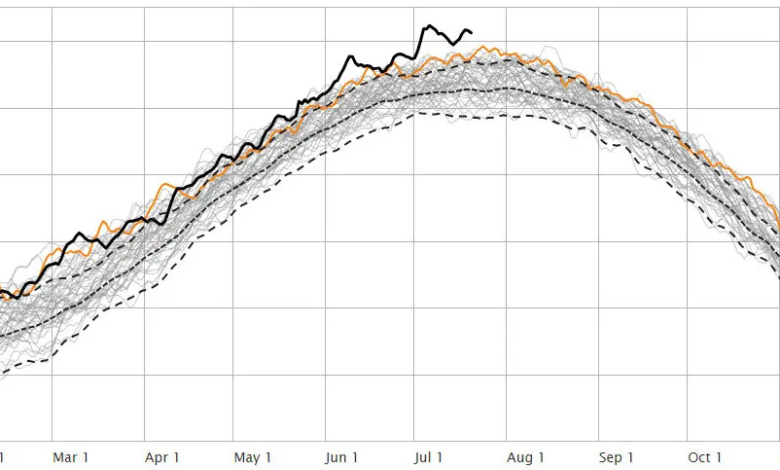July (and 2023) to global warming record

“We expect 2024 to be even hotter,” comments NASA
(sustainabilityenvironment.com) – July 2023 has excellent chances to become the hottest ever. Since the 3rd day of the month, global air temperatures, measured at 2 meters above the ground, have remained consistently above the previous record of hot 24 July 2022 (equal with 13 August 2016). In both cases, the peak heat had been, in fact, a peak. And in less than a week the values had returned lower. Today, however, we are not facing a peak but a real plateau that projects July towards a new record of global warming.
July 2023 towards a new global warming record
After the record broke the first week of the month, when the global average air temperature had reached 17.23°C on July 6, marking a thermal anomaly of over 1 degree (+1.02°C) compared to the average climate of the reference period 1979-2000, the global mercury column is down. But without ever going below the ’22/’16 record. The descent ended on July 14 at +16,96°C (anomaly of +0,71°C), and then run upwards again until the new peak of 17,17°C reached on July 18.
According to NASA’s Director of the Goddard Institute, Gavin Schmidt, these values make it almost certain that July ends in first place in the ranking. And they bring a 50% chance of 2023 becoming the hottest year ever globally, kicking 2016 and 2020.
“But we expect 2024 to be an even hotter year, because we will start it under the influence of the El Niño event that is now being built and will peak towards the end of this year,” he specified. It is estimated that El Niño can add up to 0.2°C of global warming in a given year. The 2023, according to the projections of the European satellite system Copernicus, is on the trajectory to become 1.37 ºC warmer than the average of the pre-industrial era.
“We’ll beat the 2C”
Weighing on the global temperatures of 2023 and this July in particular are both the heat waves that are affecting Europe, China and the United States, both the very high temperatures of the seas in much of the world. The global thermal anomaly has been consistently on record since April and in the North Atlantic since March. “We are seeing unprecedented changes around the world: the heat waves we are seeing in the United States in Europe and China are breaking records,” said Schmidt. “For many months now we have seen record-breaking sea surface temperatures, even outside the tropics. And we expect it to continue, and the reason we think it will continue, is because we keep putting greenhouse gases into the atmosphere”.
In an interview with BBC Today broadcast on July 20, Schmidt said he was “pessimistic” not only about respecting the 1.5 degree limit, but also about limiting global warming below 2 degrees. “I think most people are worried that if we give up the 1.5°C, which I don’t think we’ll respect, I’m actually very pessimistic about respecting the 2°C, too, that if we allow the goal to become more and more flexible, higher and higher, governments will do even less in the future,” he said.





